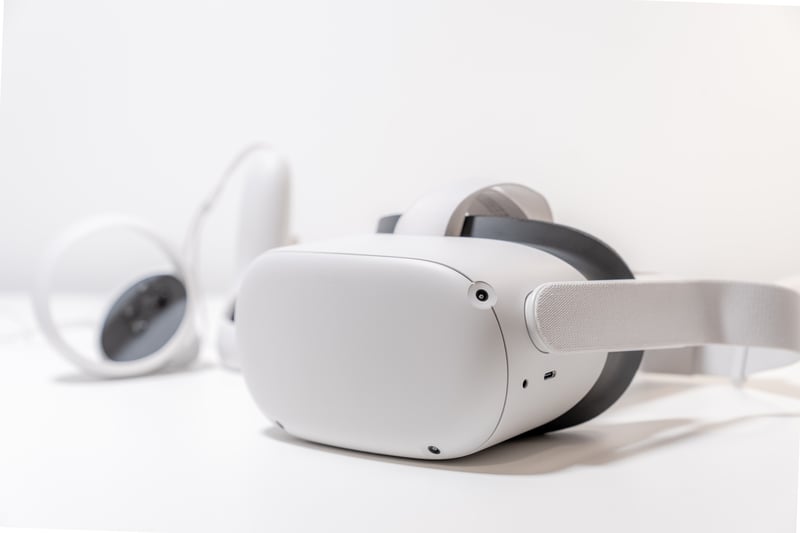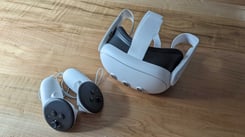It’s always an exciting time when new VR Headsets are announced. It gives us a chance to see the latest trends from developers and get excited about how we can get even more immersed in the technology. In recent years we’ve been most excited about the new devices coming from Meta especially when they announced the original Quest headset back under the original Oculus VR brand. The idea of a “standalone” VR headset was and still is a game changer. Losing the high-end PCs and opening where you could experience VR was a big boon for both casual and professional VR users. Since the original Quest, we’ve got the Meta Quest 2 and Meta Quest Pro, with the former being our current top recommendation for VR Users.
At the beginning of this month, we were surprised with the announcement of the Meta Quest 3, the latest standalone VR device from Meta aimed at casual VR users. The new Meta Quest 3 features fall in line with trends we are seeing in the industry (more on that in a bit) but there are also some nice surprises that we hope to see elsewhere. Join us as we break down the newest Meta Quest 3 features and specs and where we see this device going in our industry.
A Bump in Tech Specs
The first Meta Quest 3 features to examine are the expected ones: an increase in processing power and improvements to the device hardware. Meta has announced that the device will feature a brand-new Snapdragon chipset developed specifically for Meta devices. They claim that this will almost double the graphical performance of the headset, which is great for VR experiences on the device. It will also most likely mean just a faster device in general.
Meta has also stated that the headset will have its highest resolution display and pancake optics. However, we have yet to hear the specific resolution of the display, but based on their claims experts are predicting a resolution of around 4,128 by 2,208 pixels (2,064 by 2,208 pixels per eye) which would be an improvement over Quest 2’s 1,920 by 1,832 per eye. And again, we didn’t hear any specifics from Meta regarding the refresh rate, but the standard today is still 120Hz. As we learn more about the Meta Quest 3 Features from Meta we can more closely examine if the screen gets the upgrades we are expecting.
Passthrough and AR Continue to Trend
One of the main new Meta Quest 3 features is the upgrade to full-color pass-through and enhanced Augmented Reality features. The Meta Quest Pro made waves earlier this year with their mixed reality headset with a focus on Augmented Reality. It looks like they wish to continue that with the Meta Quest 3. Trailers show it being used to play tabletop games virtually. Still, it will be interesting to see if it can be used for productivity and business purposes like how much of the Quest Pro was marketed to do so. And it will be interesting to see how the Quest 3 stacks up to its much more premium Quest Pro counterpart in this regard.
A Redesign for Comfort
If you’ve used any VR headset you know that there can be a slight discomfort with extended use of the headset. Most VR devices are very front-heavy as most of the hardware sits in front of the eyes. They often try to offset it with their head straps, however, that can only do so much. After a while, you’ll most likely feel the pressure of the headset on your nose or cheekbones. One of the new Meta Quest 3 features looks to make things more comfortable and that’s a matter of a redesign. The headset is now much thinner (40% according to Meta) and with that comes some better weight balancing to ease the strain the headset can have. One of the other Meta Quest 3 features that have been redesigned is the brand-new controllers. With improved haptics and the removal of the tracking ring, they are much smaller.
The Quest 2 isn’t Being Forgotten
Along with their announcement of the Meta Quest 3, Meta also recognized the impact that the Meta Quest 2 has had on the market since its release back in 2020. They recognized its impact as an affordable entry for many into the premium VR market. They announced that with the release of the Meta Quest 3, they would be lowering the price of the Meta Quest 2 to $299 USD for the base model, making it even more affordable. They are releasing an upcoming patch that will increase the computing power of the Meta Quest 2, with up to 26 % CPU performance increase and up to a 19% GPU speed increase for Quest 2. This is great to hear and continues to make the Quest 2 a viable option for users.

That sums up the majority of the new Meta Quest 3 features. It’s the expected list of upgrades that users would want to see today and falls in trend with other recently released devices. However, the improved design and performance will be welcomed by VR enthusiasts. As the launch approaches, we will have to see how much interest in the product builds and if those in the architecture and design industry see more of a use for it in their workflows.
In the meantime, you can check out our recommendations for the top VR devices for architecture firms and our breakdown of the Meta Quest Pro and its approach to mixed reality.







